On The Town … With Chip Deffaa .. April 4, 2016
it’s significant that Steve Martin has won five Grammy Awards for albums he’s made–two in the category of “comedy,” and three in the category of “music.” He loves to play the banjo (an instrument, incidentally, that has a prominent role, along with the fiddle, in the music we hear in “Bright Star.”) He’s collaborated with Edie Brickell on two albums.
Boy! This is turning out to be one terrific theatrical season in New York.
The new musical “Bright Star,” which just opened at Broadway’s Cort Theater, struck me as astonishing theater–as fresh, original, and inventive as anything I’ve seen in quite a while. I loved every bit of it. And I can’t wait to see it again. Ordinarily, if a rewarding show opens in New York, it arrives rather noisily, with all sorts of buzz about it, and plenty of advance publicity. However, this show took me completely by surprise. It crept into town very quietly–very little advance PR–and simply let us discover it. What a happy discovery!
In a season so thoroughly–and understandably–dominated by “Hamilton,” it’s been hard for other shows–no matter how worthy–to get much publicity. But I sure hope “Bright Star” finds its audience. In an ordinary season, it’d get much more notice, and would surely win assorted awards. “Hamilton” will no doubt dominate the awards this year. It is the show of the year. (You can just feel it, much the way you could feel it back when, say, “The Producers” or “Rent” were clearly the shows of their particular years.) But there is much about “Bright Star” that is great and fulfilling in its own “American Roots” kind of way, and deserving of recognition. And I haven’t seen a stronger performance by an actress in any musical this season than that given by Carmen Cusack–who’s totally new me–in this production. 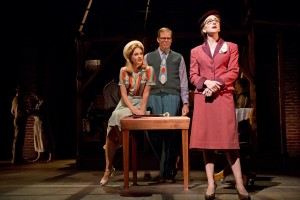
Written by Steve Martin and Edie Brickell, directed by Walter Bobbie, with choreography by Josh Rhodes, “Bright Star” is a succession of surprising delights. The unusually strong cast is impeccable. There is not a weak link. What a wonderful mix of seasoned pro’s–including some long-time personal favorites of mine–with some great new discoveries: Paul Alexander Nolan, A. J. Shively, Carmen Cusack, Stephen Bogardus, Dee Hoty, Stephen Lee Anderson, Michael Mulheren, Jeff Blumenkrantz….. And every one of them had a meaningful contribution to make.
The show has lots of warmth and heart, and life, and wit. Set in the South in the 1920s and ‘40s, it’s unlike any other show on Broadway right now. And the staging is extraordinarily fluid; the transitions from scene to scene are brilliant. I’ve always enjoyed Walter Bobbie’s work, but this is his masterpiece.(I want to watch it again, and again, just to study his transitions; it was like witnessing a fine ballet, just seeing the way he let one scene flow into the next. Every aspiring director and choreographer should study the way each scene yields to the next in this beautifully paced musical play.)
I watched “Bright Star” in wonder, from the front row, caught on multiple levels–the storytelling, the music, the acting, the movement–right from the opening. This musical has really rekindled my love of theater. And it’s refreshing to see a show of this quality these days that is not based on a pre-existing (and extremely familiar) film, play, or movie. It’s a joy, as an audience member, to have no idea what might happen next–and be captivated by what the actors and musicians and creative team are offering us.
The show makes some demands of us as audience members. And in an era of often dumbed-down work, I like that. The structure is a bit unconventional. The story unfolds in its own zig-zagging way. Scenes are of wildly uneven length. But it works.
 At first, the musical, set in 1945-46, seems to be about a soldier returning home to North Carolina after the war (played by a most appealing newcomer, A. J. Shively) and his father (the ever-appealing, ever-reliable Stephen Bogardus, whose work I’ve enjoyed since he was 19, some decades ago). Then, after about 15 minutes, the show flashes back to 1923, and seems to be mostly about one Alice Murphy (played Carmen Cusack, making her Broadway debut–and what a richly varied, Tony-worthy performance she gives!). It takes quite a while before we fully understand how the two different stories, in two different time periods, connect But trust me, it’s well worth the wait.
At first, the musical, set in 1945-46, seems to be about a soldier returning home to North Carolina after the war (played by a most appealing newcomer, A. J. Shively) and his father (the ever-appealing, ever-reliable Stephen Bogardus, whose work I’ve enjoyed since he was 19, some decades ago). Then, after about 15 minutes, the show flashes back to 1923, and seems to be mostly about one Alice Murphy (played Carmen Cusack, making her Broadway debut–and what a richly varied, Tony-worthy performance she gives!). It takes quite a while before we fully understand how the two different stories, in two different time periods, connect But trust me, it’s well worth the wait.
Steve Martin–who is best known as a comic actor–gets credit as a creator of the original story, the book, and the music. (Edie Brickell gets credit as a creator of the original story, lyrics, and the music.) Many will no doubt be surprised that Steve Martin has co-created a musical (and a very good one, at that). But it is a logical next step in his evolution, and I hope that he and Brickell will do more musicals together. Although many casual fans may think of Martin as simply a comic actor, it’s long been clear he’s a gifted storyteller. He did not just star in such films as “The Jerk,” “Roxanne,” “Bowfinger,” and “L.A. Story,” he wrote the screenplays for those films. He’s also written such plays as “The Underpants” and “ Picasso at the Lapin Agile.” He wrote a well-received novel, “Shopgirl.” His credentials as a writer are certainly solid.
And it’s significant that Steve Martin has won five Grammy Awards for albums he’s made–two in the category of “comedy,” and three in the category of “music.” He loves to play the banjo (an instrument, incidentally, that has a prominent role, along with the fiddle, in the music we hear in “Bright Star.”) He’s collaborated with Edie Brickell on two albums. And their ongoing musical collaboration has provided the foundation and inspiration for this engrossing musical play.
And oh! While we’re talking about music, I don’t want to forget the musicians who add so much to the joy of this show. Rob Berman led 10 sharp players (notably including, the night I attended, Paul Woodiel on fiddle, and Bennett Sullivan on banjo) through a fresh, bluegrass-based score. August Eriksmoen’s orchestrations make wise use of mandolin, accordion, viola, cello, guitar, autoharp, and other instruments to create appealing sounds that have ties to both Appalachia and Broadway. And Berman, besides serving as musical director/conductor and vocal arranger, played keyboards with feeling. In the scene set at the Shiny Penny lounge, his piano playing didn’t just contribute “atmosphere,” it was sensitive, beautiful and heartfelt; I was enjoying it in its own right, the way I might enjoy a pianist at, say, the Village Vanguard jazz club. The same went for his contributions during the song “At Long Last,” which was among my favorites.
Rob Berman, I might add, has been quite busy on Broadway this season; he served as music director/conductor of “Dames at Sea” earlier this season; and he’s also working on the eagerly anticipated “Tuck Everlasting.”
The dancing in “Bright Star” is vigorous, exuberant, and earthy, reflecting the show’s period Southern settings. And it is terrific. Josh Rhodes has previously choreographed such Broadway productions as “Cinderella,” “First Date,” and “It Shoulda Been You.” But this should be his breakout show as a Broadway choreographer. There’s a good bit of dancing, very well executed, with an authentic “roots” feel.
And let’s talk a bit more about the cast. It’s been a long time since I’ve been so excited about a “newcomer” to the Broadway scene as I am about Carmen Cusack. She delivers a must-see performance. Her acting, not just her singing, is first-rate. She is utterly convincing, whether playing her character as a hardened middle-aged workaholic or as a young woman in the throes of her first love affair.
The chemistry between Cusack and her well-matched onstage partner, the charmingly swaggering Paul Alexander Nolan (most recently seen Off-Broadway in “Daddy Long Legs”) is as good as it gets. And what a memorable portrayal of first love/lust/passion they give us. It’s conveyed with come-hither looks, inviting body language, inflections. Nothing explicit is shown on stage. And yet it’s all there: the heat, the desire, the love. Their connection feels as real as any I’ve seen between lovers in the theater or in film. Just wonderful interplay. And our hearts will break with her later. She’s previously starred in shows in England, as well as on tour in the US. And, if there’s any justice, this performance ought to establish her as a star on Broadway.
Steve Martin has written this musical play well. He has provided good, meaty parts for eight or nine actors. And that, too, is rare. In a musical like “Allegiance”–which I wanted to love but couldn’t–the supporting roles felt like cardboard, mere walk-ons, stock characters; and the talents of good performers like Scott Wise wound up getting under-utilized. But in “Bright Star,” by contrast, Martin’s script gives one actor after another a chance to make an impression playing a character who’s got substance. And director Walter Bobbie has chosen his cast with knowledge and care, finding actors that are perfect fits for the parts they play.
What a joy it was to see Stephen Bogardus, who projects such open-hearted warmth on stage, and has such a beautiful, silvery timbre, play the role of the father of the show’s protagonist. He brings the simple, plain-spoken man vividly to life. We feel the man’s humanity. And it’s always a pleasure to hear him sing.
A.J. Shively, a relative unknown, is a terrific choice for the role of Bogardus’s son–the returning soldier, about whom the whole story seems to revolve. He certainly seems like a plausible son for Bogardus to have had; he projects much the same solid, earnest, trustworthy, salt-of-the-earth quality. (One random side note. I couldn’t help but be reminded a bit of the passage of time, though, while watching this wonderful musical play. I must confess, I was a bit taken aback, at first, to see Bogardus, with graying hair, playing the father of the protagonist. He’s played so many younger leading roles in Broadway shows so well over the years–from “Love, Valour,. Compassion,” to “High Society,” to “Irving Berlin’s White Christmas”–I was a bit surprised to see him playing the father now. Of course it’s age-appropriate. But when he was younger, he would have been a natural choice for the role of the son And seeing him playing an older role just reminded me, I guess, that we’re all getting older.)
Great seeing them again.
Playing Mayor Josiah Dobbs is Michael Mulheren, who always makes the most of any role he’s offered, (whether he’s a well-remembered gangster singing “Brush Up Your Shakespeare” in the last Broadway revival of “Kiss Me Kate”–for which he got a Tony nomination–or a heavy on “Law and Order”). Still another bit of perfect casting: Jeff Blumenkrantz–who’s always good fun on stage–playing a prissy, sarcastic, closeted magazine editor. This might be the best role he’s had since he played Bud Frump in the Matthew Broderick revival of “How to Succeed.”
Much, much to love about this production.
Oh, there were some minor flaws, as there are in nearly all shows. At times, Brickell’s lyrics were a bit more obvious than I would like. There are moments of heightened emotion in a show when a lyric that states exactly what is going on (which we all are already aware of) just feels awkward to me; it’s better to have a lyric that tells us something we don’t already know, or at least tells us what we know in a way that is somehow unexpected. Occasionally–not often but occasionally–Brickell’s lyrics had, for my tastes, the too-obvious feel of a first draft I wish someone had urged her to rethink a few lines. A few lines could still use some tweaking. But there is so much to marvel at in this musical, and so much that is fresh, and bracing, and uplifting, I could forgive or look past those occasional lapses. This was, for me, a very rewarding show. I look forward to seeing it again.
It added to the pleasure of the night for me that I ran into one artist after another in the audience, before the show started, or at intermission, or afterwards. I was happy to see, for example, Jay A. Johnston, who’d most recently co-starred as “Chip” in the Broadway revival of “On the Town” (which he told me he’ll be doing on the West Coast next); the highly respected songwriter David Friedman; stand-up comic Shawn Moninger (appearing at the Metropolitan Room as I type this); singer Magnus Tonning Riis, who’d just been in a concert at 54 Below, and so on.
And it was wonderful to see–and chat with–Miss Margot Moser. As a boy, I got to see her co-starring in “My Fair Lady” at the Mark Hellinger Theater, near the end of that classic musical’s long original Broadway run. She was the fourth actress–and the very first American–to play the role of Eliza Doolittle, which Julie Andrews had originated. My whole family went to see :”My Fair Lady” on Broadway. 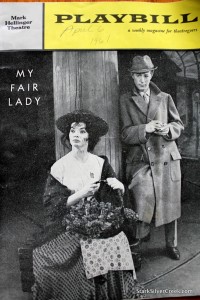 (The cast album–which I still have–had gotten constant play in our home.) And while my parents, and my brother and sister all very much liked the show (my sister said, “Let’s see it again, let’s stay for the next show!”), I fell in love with the show, and with Broadway, and with New York, all at once. It was magical. And Margaret Moser was very much part of that magic.
(The cast album–which I still have–had gotten constant play in our home.) And while my parents, and my brother and sister all very much liked the show (my sister said, “Let’s see it again, let’s stay for the next show!”), I fell in love with the show, and with Broadway, and with New York, all at once. It was magical. And Margaret Moser was very much part of that magic.
So it was very meaningful for me to run into Margot Moser now–she’s in her 80s, and still beautiful, still immediately recognizable. I told her how much that show had meant to me, and began reciting the names of the actors in the cast; they were all imprinted upon my memory: Margot Moser, Michael Allinson, Gordon Radd, Melville Cooer, Gordon Diilworth…. . My lifelong love affair with the theater began with that gorgeous musical. In her prime, Margot Moser did–one place or another–all of the great roles that were written for a lyric soprano, from “Carousel” to “The King and I.” And for a while, she co-starred on a TV show. Then she became a highly regarded singing teacher/vocal coach. Meeting her at “Bright Star” really gave the night a perfect ending for me.
She told me she admired the way the actors in “Bright Star,” playing Southerners, mastered their accents so convincingly. High praise from the first American ever to play the cockney Eliza Doolittle in “My Fair Lady.”
* * *
When I have a night as thoroughly satisfying as that one was, I often don’t want to go out again for a while. I just want to sort of bask in the moment. But sometimes you have to go out–you’ve got the tickets, you’ve made the commitment–whether you want to or not.
The night after I saw “Bright Star,” I found myself watching a very bad production, out in New Jersey, of a show that shall remain nameless. No point in embarrassing the theater, the actors, or the director. I don’t write about every production I see. Life is too short for me to feel a need to comment on every example of bad acting, bad writing, or bad direction I see.
But this time, I have to say something. Because the director had cast two romantic leads who had no chemistry at all. I never for a moment believed their was the slightest bit of attraction between them. And then when the time came for them have their first kiss, the director had them lock lips for the longest-held kiss I’ve ever seen on stage. They didn’t move, they just clenched for so long I wondered when they’d come up for air. I grew impatient, because the endless kiss was getting in the way of the storytelling. And also because it didn’t feel as if it were–even slightly–real. I felt like I was simply witnessing two actors who’d been instructed by their director to hold a kiss as long as possible. And there was nothing romantic or sexy, or even particularly interesting about the scene at all. It was just as if a bad director imagined that a really long kiss would somehow represent lust or longing or romance or passion, or some strongly-held emotion. But it was almost comical. I thought the theater should have hung up a warning sign outside: “Bad direction within.” That was one night when I wished I had simply stayed home.
* * *
“Man of La Mancha, “ which is playing at the Westchester Broadway dinner theater through May 1st, is one of the better productions I’ve ever seen at that theater–and is warmly recommended. (And ticket prices in Westchester are modest, compared to those in New York City.) 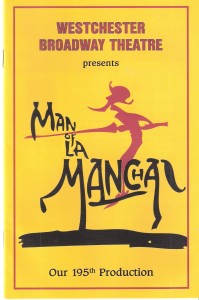
Paul Schoeffler (who’s appeared on Broadway in “Rock of Ages,” “Peter Pan,” “Beauty and the Beast,” “Nine,” and “Sunday in the Park with George”) is an excellent “Don Quixote.” (And I’m not easy to please, having seen this show-with great leading players–in its original Broadway run and its most recent Broadway revival.) But Schoeffler’s acting, as well as his singing, is just what you hope for–earnest, strong, sensitive. Achingly vulnerable when needed. He sings and speaks with utter conviction. He’s a terrific choice for the role. And Michele Dawson (whose Broadway credits range from “Ragtime” to “Spider-Man”) was a fine “Aldonza”/”Dulcinea.” The show is effectively performed – as was the original – in minimalist fashion. There’s very little in terms of set; and very little is needed. The storytelling does not require more.
Some of the supporting players in this production are mere journeymen. (And that’s a pity, because opportunities for a richer production were lost. When I first saw “Man of LaMancha” on Broadway, I got to see in the role of “Sancho Panza” Joey Faye–whose masterful comic timing was honed through years in burlesque, before he moved into legitimate theater; he found much more in the part than the adequate actor cast in the role at Westchester Broadway did.)
But even if some of the supporting roles were played without great flair, Schoeffler is so compelling, and director/choreographer David Wasson (who’s appeared as an actor in the show some 1400 times over the years) understands the story so well, the production is quite satisfying. The material is strong. The star was commanding. I was pulled in from the start.
Andrew Gmoser’s lighting is superb. The way he lights the opening scene, heightening the drama of the shadowy figure descending the staircase, sets the tone brilliantly. The score by Mitch Leigh and Joe Darion is, needless to say, filled with riches: “Dulcinea,” “Man of La Manha,” “Little Bird,” “The Impossible Dream…..” So much memorable melody. And the lyrics seem to grow organically out of Dale Wasserman’s libretto. Kudos, too, to the six-piece orchestra, under the direction of Patrick Hoagland, which does a surprisingly good job of evoking the music many of us know so well from the original cast album.
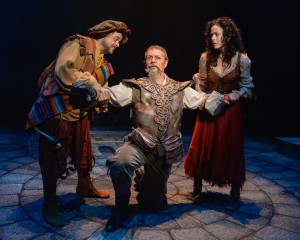 The soaring idealism of this show–which I took for granted when the show originally debuted in the 1960s–feels very much welcome at this time. During the intermission, the people at the table next to me began talking about Donald Trump and the coarsening of American politics. I was very much eager to return to Don Quixote’s world. His fantastic desire to see the best in others, and to fight courageously for the right, despite the odds, spoke even more strongly to me now than when I saw productions of the show in past years. It’s still powerful theater. And it fits comfortably on the Westchester Broadway stage.
The soaring idealism of this show–which I took for granted when the show originally debuted in the 1960s–feels very much welcome at this time. During the intermission, the people at the table next to me began talking about Donald Trump and the coarsening of American politics. I was very much eager to return to Don Quixote’s world. His fantastic desire to see the best in others, and to fight courageously for the right, despite the odds, spoke even more strongly to me now than when I saw productions of the show in past years. It’s still powerful theater. And it fits comfortably on the Westchester Broadway stage.
Oh! How I enjoyed the best moments of the Nutmeg Ballet Company’s Spring “Impact” show, in Torrington, Connecticut. (Production photos by Susan Marine Suhanovsky.) I would gladly have watched the show a second time, if my schedule had permitted. So much that was rewarding. .Let me just mention a few personal favorites–high points, for me, of an unusually strong “Impact” show.
What a treat it was to see the balcony scene from “Romeo and Juliet” (music by Sergei Prokofiev, staging by Eleanor D’Antuono and Victoria Mazzarelli), sublimely executed by two exceptional dancers, Alma Evertz and Alexsander Keeperman. They are not only magnificent dancers individually–perhaps Nutmag’s best in the field of classical ballet, and the choreography showcased their particular assets beautifully–they make an unusually good combination. The chemistry between them is just right; they make a fascinating onstage team. This was true enough when I saw them in “The Nutcracker” in December; it is even more true now. Her willowly grace, his strong, supple movements are complementary. I did not want this piece to end.
Subtle, fluid, richly romantic, the ballet was superbly staged and executed. Even slight gestures–now the two briefly looking away from each other, now looking towards each other–seemed evocative of the give-and-take of love. The dance evoked so much–so perfectly–of the tenderness and strength, the shyness and attraction, the growing longing of young love. So much was conveyed, just through movement and music. (Well! Profofiev’s music would want to make anyone fall in love! And dance while doing so.)
This was a wonderfully romantic scene–far more so than so than the typical love scenes I see on stage. Evertz, incidentally, is the daughter of two highly accomplished dancers; there may be well be something in the genes there. But both she and Keeperman are blooming as dancers in a way that is rewarding to witness. Their growth in the past year has been dramatic. They both have very bright futures ahead of them. .
I enjoyed as much–in a very different way–a brusque, surprise-filled modern group piece being presented for the first time anywhere: “Beloved,” featuring choreography by Brian Reeder (who’s been a guest artist with Nutmeg for three years) and music by David Lang. The stage was filled with 14 dancers (including some I’ve long enjoyed at Nutmeg shows, such as Jennifer Schwartz, Grace Canfield, Kaliece Carter, Demeri Sutula). Showcased to particularly good advantage on this piece was Andris Kundzins. It is always a joy to watch him work–I look forward to seeing him dance–and he really “gets” this kind of cool, angular contemporary movement. He was a standout.
But every member of the ensemble was contributing to the success of the piece. And there were opportunities for each to add to the impact. I loved the finesse with which Tim Dobbins executed his final turn and gesture, as he left the stage; even the very last detail felt finished, and I admired that. I love that kind of attention to detail. (Random comment. Watching Dobbins, I was remembering how much pleasure I used to get from watching Mark Myars in Broadways shows, back when he was dancing a lot; he’d execute turns in second with such flair and polish; and then I’d see someone else cover the same role another night, rather indifferently, and I’d realize how much getting the details right matters, and can affect the whole feel of a show. And even with a stage filled with dancers, someone in the audience is likely watching what any given dancers is doing)
Yay for choreographer Kate St. Armand and her 13 exuberant young dancers, who premiered a dazzlingly theatrical piece called “Secrets.Me,” set to boistrous music by Raphael Beau. By turns playful and intense, mixing moments both dark and light–as if she’d bottled teen angst and energy and given her dancers an extra dose–it was great fun. I like Armand’s work. She can take comparatively simple but attractive moves, and combine them in ways that an ensemble can execute easily and naturally, with plenty of spirit and showmanship. The program notes said that Armand developed the piece by asking the dancers to share secrets in confidence, which then helped inspire the piece. I like that concept. The results–however they were arrived at–were great fun.
And I got a kick out of noticing that the dancers were wearing Tiler Peck outfits. (Tiler Peck, besides being a wonderful principal dancer with the New York City Ballet–I love her work–also has her own line of dance wear now. (You can check it out – and make a purchase if you like – at http://www.tilertalks.com) It felt like Tiler Peck–who’s impressed me since she was even younger than the young dancers now wearing her outfits–was there in spirit. And I enjoyed seeing, among the dancers participating with such welcome elan one Rachel Kundzins, kid sister of the aforementioned Andris Kundzins; although quite young, she’s clearly got those dancer genes, too. Just for fun, I’m posting a photo of Rachel Kundzins in one of Tyler Peck’s outfits. (Tiler Peck says she gets a kick out of seeing the young dancers in her outfits, too.)
By the way, if you’d like to learn a bit more about Tiler Peck, she’s profiled in the latest issue of “Danceinforma Magazine.” (You can read it online here: http://www.danceinforma.com/…/chatting-with-nycb-principal…/ .) She had something, even when she was just a kid of 11, when I first met her, when she was doing “The Music Man” (directed/choreographed by her original mentor, Susan Stroman) on Broadway. So did her young castmate Chase Brock, today a leading choreographer on Broadway and in the regional theaters. (His latest gig? Directing and choreographing “The Music Man” at Flat Rock Playhouse–a show he certainly knows well, having done it on Broadway for two years as a teen. I can close my eyes and still see his high-flying dancing in that terrific Broadway production, which I had the pleasure of watching a number of times–including one time from the wings!)
Back to the Nutmeg Impact show. I like that the program also included a scene (“The Kingdom of the Shades”) from “La Bayadere” (one of the early abstract ballets, set to music by Ludwig Minkus, and always a favorite of mine). Demeri Sutula, Grace Canfield, Jennifer Schwartz got to dance the variations; and the 18-member corps de ballet got to show their ensemble skills. I know the hard work that goes into creating such pleasing ensemble pictures on stage.
Watching this, I was remembering a teacher instructing me in the rudiments of ballet when I was a child, telling me in effect: “You’re learning an international language. You’re not just learning positions and movements, you’re learning a language understood by dancers all over the world.
And there’s truth in that. Shortly before I saw the Nutmeg dancers perform this scene from “La Bayadere,” I was enjoying a visit with a friend who’s a dancer in the Paris Opera Ballet Company. We went to see a Broadway show together, and he was talking about performing “La Bayadere” in Paris. And now he’d returned to Paris, and I was watching an interpretation of “La Bayadere” in the U.S. And thinking that dancers do indeed speak a universal language.
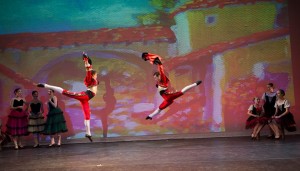 The program concluded with “Don Quixote” (featuring music by Ludwig Minkus, and choreography based on the original choreography of Marius Petipa)–a big, colorful ballet that allowed some three dozen dancers to fill the stage. I was happy to see Matanya Solomon, recovered from an injury that had long sidelined him, finally getting a chance to fully show what he’s capable of. He rose to the occasion with aplomb. And Riley McGregor–always fun–was an excellent counterpart for him; they’re well-matched in terms of onstage personalities and physicality. Isabel Jennings, Covington Pearson, Mary Colombie, Cassandra Punzo all had contributions to make.
The program concluded with “Don Quixote” (featuring music by Ludwig Minkus, and choreography based on the original choreography of Marius Petipa)–a big, colorful ballet that allowed some three dozen dancers to fill the stage. I was happy to see Matanya Solomon, recovered from an injury that had long sidelined him, finally getting a chance to fully show what he’s capable of. He rose to the occasion with aplomb. And Riley McGregor–always fun–was an excellent counterpart for him; they’re well-matched in terms of onstage personalities and physicality. Isabel Jennings, Covington Pearson, Mary Colombie, Cassandra Punzo all had contributions to make.
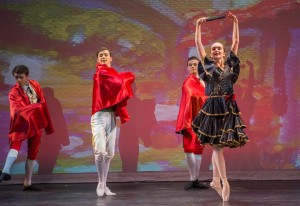 It’s fun when artists begin to show their potential. I liked the zest and enthusiasm of Benton Stivali, and the crisp confidence and presence of Julius Taiber, playing toreadors. (If someone walked into an audition for a show of mine with the confidence and presence Taiber exhibited, I’d find a role for him; it’s a wonderful quality for a performer to have.) I’ll look forward to seeing their continued growth. They’re giving off sparks of talent.
It’s fun when artists begin to show their potential. I liked the zest and enthusiasm of Benton Stivali, and the crisp confidence and presence of Julius Taiber, playing toreadors. (If someone walked into an audition for a show of mine with the confidence and presence Taiber exhibited, I’d find a role for him; it’s a wonderful quality for a performer to have.) I’ll look forward to seeing their continued growth. They’re giving off sparks of talent.
I’ve gone to Nutmeg shows whenever possible (whether I’ve written about them or not) for years. It’s always interesting to watch the progress of performers from year to year. Dancers who initially seemed to be anonymous background players gradually–if all goes well–not only gain in technical skills, they gain in individuality and power until they command attention. And some of the minor players of one season will be Cavaliers of future seasons. Some of the “flower girls” in :”Don Quixote” this year will be future principals.
* * *
My life has always been rich with dancers. Jon Peterson, with whom I’ve worked so much in the past decade or so, trained with the Royal Ballet in London, where he grew up. He then went on to perform in one major musical after another on the West End–“Cats,” “The Sound of Music,” “Sophisticated Ladies,” and so on He was brought over to America to star in the national tour of “Cabaret.” And for some 10 years, off-and-on, since I directed him Off-Broadway in New York at the Irish Repertory Theater, he’s been starring in productions of my show “George M. Cohan Tonight!”
As I type these words, he’s back in London, doing a reprise there of “George M. Cohan Tonight!” And we’ll take the show back to Korea in July. It’s always a joy for me to see him onstage. I hope he’ll do that shows of mine for many more years to come.
I spent today in the recording studio with Giuseppe Bausillio, another of my favorite performers to work with. He’s already got three Broadway shows to his credit, and he’s just 18! He’s also a regular on the TV series “The Next Step,” playing an aspiring dancer–which makes sense since he’s been winning medals in international dance competitions since he was a kid!
I’m enjoying seeing the commercial for “An American in Paris” on TV. They really capture the feel of the show. And I’m glad to see dancer Robbie Fairchild in the commercial–even if he’s recently left the show in which he did such a good job as star. He’s back with the New York City Ballet.
* * *
I was sorry to note the passing this week of Frankie Michaels. Originally from Bridgeport, Connecticut (birth name: Francis Chernesky), he was the youngest actor ever to win a Tony Award. He won one when he was just 10 years old, playing young Patrick in the original Broadway production of “Mame,” starring Angela Lansbury. And his fine clear singing voice–which I remember well–is captured on the original cast album. He sang “My Best Girl” to Angela Lansbury. (And she appeared delighted to reunite with him at a salute to her in New York a couple of years ago.)
He became a regular on the soap opera “As the World Turns.” He appeared in the Off-Broadway shows “Happily Ever After” and “‘A’ for Adult,” and continued to sing in clubs and casinos up until his death. (But fame and fortune do not last forever, and some of us were poignantly reminded of how tough this business can be when he quietly offered up his Tony Award for sale a few years ago.) He died at his home in Chittenango, NY. He was 60. He is survived by his son, Michael Lloyd Chernesky; his sister, Felicia Hreschak; his companion Lucille Bort; and his close friend Steven Clark.
* * *
Kelsey Grammer gave his final performance on Sunday night (April 3rd)–playing the dual roles of Charles Frohman and Captain Hook–in the Broadway musical “Finding Neverland.” The first photo shows him standing in the wings, along with castmate Jackson Demott Hill, preparing to take his final curtain call.
Grammer may be best known for his work in television (on the sitcoms “Frasier” and “Cheers”), but he’s periodically done theater. (I saw him last on Broadway, starring in “Macbeth.”) And he’s a producer of the Broadway show “The Color Purple.”I admired him for doing “Finding Neverland.” He certainly doesn’t need the money. He didn’t have the most prominent role in the show. (“James Barrie” was clearly the main role.) And on any given night he ran a risk of being upstaged by assorted exuberant kids and one adorable dog–crowd-pleasers, all. But the roles he played in the show suited him well, audiences liked him, and I’m sure his name helped sell tix, and played an important part in getting “Finding Neverland” established.
– CHIP DEFFAA, April 5, 2016

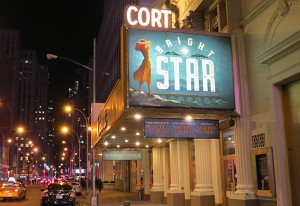
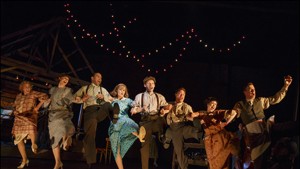
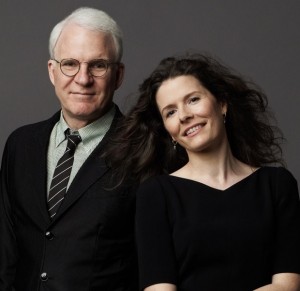

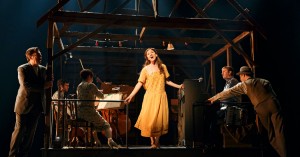
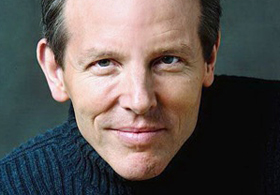
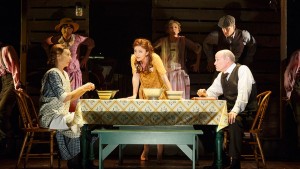
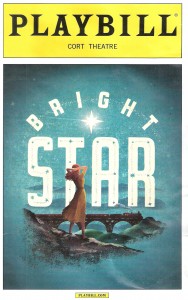
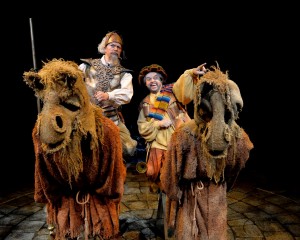
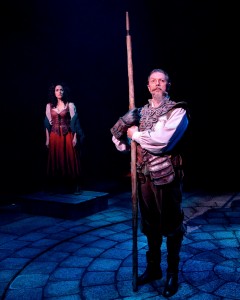
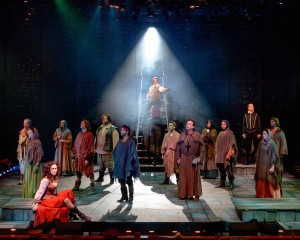
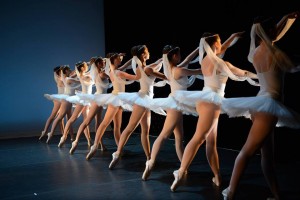
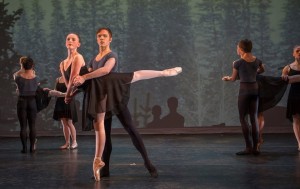

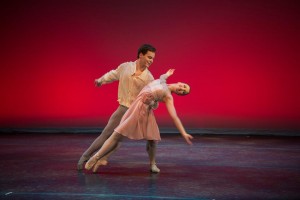
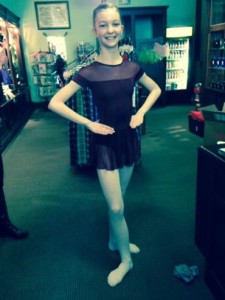


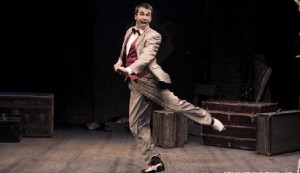
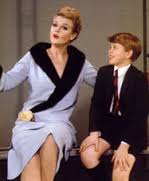
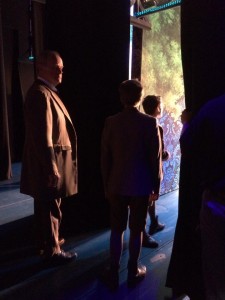






Leave a comment